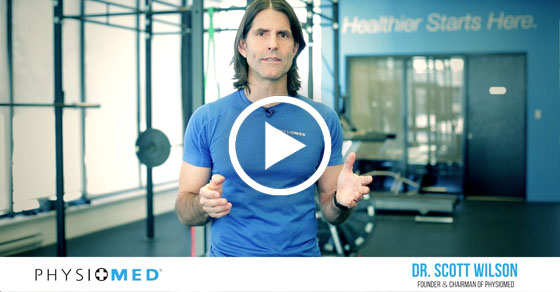Osteoarthritis Treatments: What You Need to Know...
Key Highlights: Osteoarthritis treatments focus on pain relief, restoring joint…
Read More
Posted by Dr. Scott Wilson | 10-Feb-2019
Hi, I’m Dr. Scott Wilson, founder and chairman of Physiomed. According to the Canadian Institute for Health Information, cycling, skiing and snowboarding are among the top sports that land Canadians in hospital each year. This month we’re looking at how to prevent and overcome sports related injuries. So let’s check in with doctor Jason Lemieux of Physiomed Oakville, and he’ll give us some tips on how to avoid injuries and keep yourself in the game.
I’m Dr Jason Lemieux of Physiomed Oakville. Anyone that’s been involved in sports may have to overcome a sports injury. As someone that’s been there, I can tell you that overcoming an injury can be both physically and psychologically challenging. When we get injured, we have to deal with the acute phase of injury, but ultimately we want to look at how can we prevent future injuries. The rule of thumb is typically been after an acute injury to follow R.I.C.E. , the acronym of rest, ice, compression, and elevation.
Did you know that the MD that coined the phrase R.I.C.E. has actually walked back his recommendation. Research actually shows that rest and the application of ice can actually delay the healing process and slow down the resolution of swelling. When you’re acutely injured the biggest issue is dealing with the swelling. In North America, we’re conditioned to think that inflammation is the enemy and as soon as we’ve been injured, we have to reach for an anti inflammatory. That’s not actually true. Inflammation during an acute phase is not our enemy, it’s actually our friend. Swelling that accompanies inflammation is the real problem. So while rest and the application of ice may delay the resolution of swelling, research shows that non-painful movement and compression are the best modalities to eliminate swelling. So rather than looking at absolute rest, we want to do as much non-painful motion as possible during those early stages and use compression therapy, whether it be a tense or wrap or a compression garment to minimize swelling.
Once we’ve overcome the acute phase of injury, we have to start looking at preventing future injuries. The best way to prevent injuries is to understand the concept of “move well before you move often”. So when we go to play a soccer match or go downhill skiing, we have to make sure that our body’s physical capacity is greater than the demands of the sport we’re going to play. If your knee range of motion barely reaches the amount that you need to tuck going down the hill, spending an entire weekend skiing is going to be probably too taxing for your knee. The best way to ensure that your body moves a well enough to participate in your activity is to seek out a healthcare provider and get physically screened. By assessing your range of motion, mobility, stability, and strength we’ll be able to decide where are your biggest strengths and weaknesses so you’ll know how to properly warm up and condition yourself for your activity. If you follow that advice, now you can participate through an entire season with minimal risk of injury.

Key Highlights: Osteoarthritis treatments focus on pain relief, restoring joint…
Read More
Key Highlights: Runner's knee, or patellofemoral pain syndrome, is a…
Read More
Key Highlights: Upper back and neck pain can be caused…
Read More
Key Highlights: Many people want to lose belly fat for…
Read More
Key Highlights: Vestibular physical therapy, or physiotherapy, is a specialized…
Read More
Key Highlights: Tennis elbow, or lateral epicondylitis, is a condition…
Read More